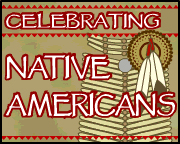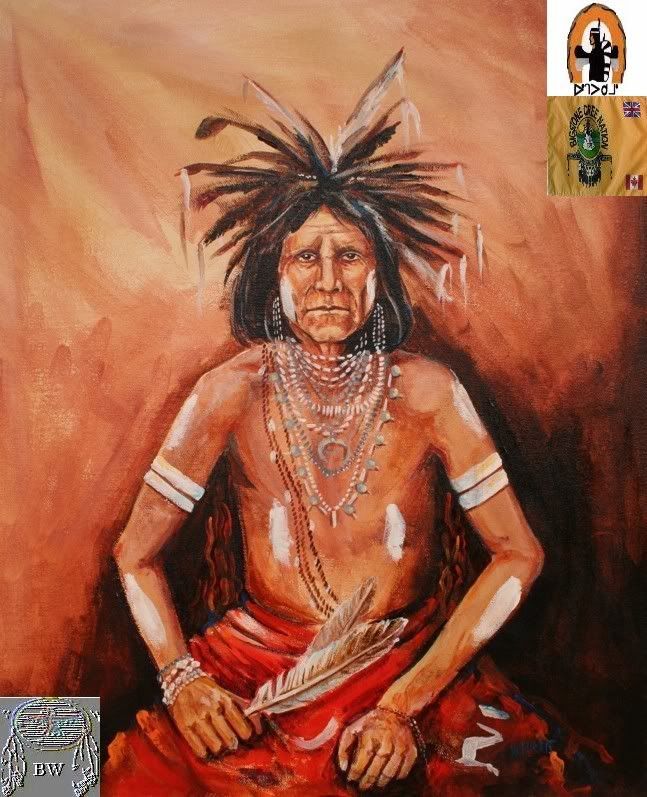|
BRAVEHORSE WARRIOR Paskwuw
Cree Warrior

 Chief Paskwuw
Warrior Citation
PASKW▄W (Pasquah, Pisqua, The Plain, known in French as Les Prairies, literally it is a prairie), Plains Cree and chief of
a band of Plains Saulteaux; b. c. 1828; d. 15 March 1889 on his reserve near Fort Qu’Appelle (Sask.). Paskw┘w was said
to have been the son of Mahkesžs (Mahkaysis), a prominent chief of the Plains Cree who died in 1872. Prior to 1874, Paskw┘w
and his band lived near Leech Lake (Sask.) where they had a few houses, gardens, and a small herd of cattle. In spite of their
unusual, if meagre, efforts at agriculture, the members of the band depended primarily on the buffalo hunt, small game, and
fish for their livelihood. Paskw┘w attended the negotiation of Treaty no.4 at Fort Qu’Appelle in September 1874, which
brought together all the Plains Indians of what is now southern Saskatchewan. The terms of the treaty called for a cession
of all Native American rights to the land in that area and a promise by the Native Americans to obey Canadian laws. In return,
the Native Americans were offered a gratuity of $7 and an annuity of $5 for each band member, $15 for each headman, and $25
for each chief. They were promised a reserve of one square mile for every five Native Americans, the maintenance of a school
on each reserve, certain farm implements, livestock, and other benefits. Each chief and headman was to receive a treaty medal
and a suit of clothing every three years. Paskw┘w’s only recorded contribution to the discussion of these terms concerned
the sale of Rupert’s Land to Canada by the Hudson’s Bay Company. He argued that the land belonged to the Indians
and that the $450,000 paid to the HBC should have been given to them. In spite of the firm refusal of the Canadian representatives
[Alexander Morris] to consider this demand, Paskw┘w signed the treaty.
Chief Paskwuw
Warrior Citation
PASKW▄W (Pasquah, Pisqua, The Plain, known in French as Les Prairies, literally it is a prairie), Plains Cree and chief of
a band of Plains Saulteaux; b. c. 1828; d. 15 March 1889 on his reserve near Fort Qu’Appelle (Sask.). Paskw┘w was said
to have been the son of Mahkesžs (Mahkaysis), a prominent chief of the Plains Cree who died in 1872. Prior to 1874, Paskw┘w
and his band lived near Leech Lake (Sask.) where they had a few houses, gardens, and a small herd of cattle. In spite of their
unusual, if meagre, efforts at agriculture, the members of the band depended primarily on the buffalo hunt, small game, and
fish for their livelihood. Paskw┘w attended the negotiation of Treaty no.4 at Fort Qu’Appelle in September 1874, which
brought together all the Plains Indians of what is now southern Saskatchewan. The terms of the treaty called for a cession
of all Native American rights to the land in that area and a promise by the Native Americans to obey Canadian laws. In return,
the Native Americans were offered a gratuity of $7 and an annuity of $5 for each band member, $15 for each headman, and $25
for each chief. They were promised a reserve of one square mile for every five Native Americans, the maintenance of a school
on each reserve, certain farm implements, livestock, and other benefits. Each chief and headman was to receive a treaty medal
and a suit of clothing every three years. Paskw┘w’s only recorded contribution to the discussion of these terms concerned
the sale of Rupert’s Land to Canada by the Hudson’s Bay Company. He argued that the land belonged to the Indians
and that the $450,000 paid to the HBC should have been given to them. In spite of the firm refusal of the Canadian representatives
[Alexander Morris] to consider this demand, Paskw┘w signed the treaty.
 The following year Native American Department officials returned to Fort Qu’Appelle to pay the annuities and to
distribute some of the articles due under the terms of the treaty. They found that Paskw┘w’s was the only band ready
to receive its cattle and oxen. At this time he stated that he wished to have his reserve at Leech Lake, where the band had
been residing. Surveyor William Wagner was instructed to lay out the required amount of land, but Paskw┘w began to vacillate.
He remained near Fort Qu’Appelle and attempted to persuade other chiefs to join in refusing to have their reserves surveyed.
Paskw┘w apparently felt that if he allowed land to be surveyed for his band, he would be submitting to the domination of the
whites. But in 1876 Native American agent Angus McKay was able to persuade the chief to permit Wagner to lay out a reserve
of 57 square miles about five miles west of Fort Qu’Appelle. Paskw┘w and his band settled on this reserve, but his intrigues
did not end. In the spring of 1878 he journeyed to Winnipeg, for an interview with Lieutenant Governor Joseph-╔douard Cauchon
of Manitoba. The chief complained that food and building materials promised to him had not been delivered. He also declared
that there was much unrest among the Plains Indians which could be alleviated if the government were to provide him with enough
food and tobacco to hold a great feast for all these Native Americans, at which he would speak in favour of the Canadian government’s
policies. Native American Department officials interpreted this suggestion as a scheme by Paskw┘w to increase his personal
influence with other bands, and denied that food or building supplies had ever been promised him. In 1882 Paskw┘w headed a
movement of the Native Americans in the Fort Qu’Appelle area against the government’s policy of paying annuities
to each band on its own reserve, rather than at a mass gathering at Fort Qu’Appelle. The Native American Department
officials alleged that the Native Americans wished to be paid their annuities at large assemblies in order to intimidate the
small party of officials, forcing them to distribute more provisions and to make more promises than the government thought
desirable. Paskw┘w had initially declared that he would not take his money but quickly capitulated on discovering that his
own band would not support him. The return of Chief Piapot [Payipwat] from the Cypress Hills in 1883 and his agitation for
better terms for the Native Americans of Treaty no.4 brought renewed tension to the Qu’Appelle district. Paskw┘w apparently
supported Piapot’s agitation but, entirely dependent upon the government for enough food to prevent starvation, he did
not make this support explicit. In the spring of 1884 a false report of fighting between the North-West Mounted Police and
a group of Piapot’s followers startled the members of Paskw┘w’s band into hasty preparations for an armed clash
with the authorities. Apart from this incident, Native American Department officials found little cause for concern with Paskw┘w’s
band during the tense months preceding the North-West rebellion. When the uprising occurred in the spring of 1885 [see Louis
Riel], Paskw┘w, together with Chief Maskawpistam (Muscowpetung) of the adjacent reserve, dispatched a telegram to Sir John
A. Macdonald proclaiming their loyalty and denouncing the insurrectionists to the north. The prime minister read the telegram
in the House of Commons, and in reply to the chiefs promised that they would be well treated. Paskw┘w died of tuberculosis
on 15 March 1889, after suffering from the disease for several years. Indian Agent John Bean Lash, who believed that the tribal
system was a hindrance to Indian progress, successfully prevented the selection of a successor. In spite of the standing of
Mahkesžs, his reputed father, Paskw┘w had little influence beyond his own band. Well known for his intrigues, he succeeded
only in annoying, not alarming, the Canadian government. In contrast to the actions of such other chiefs as Big Bear [Mistahimaskwa],
his protests were short-sighted and his demands usually trivial. From: historical accounts & records
The following year Native American Department officials returned to Fort Qu’Appelle to pay the annuities and to
distribute some of the articles due under the terms of the treaty. They found that Paskw┘w’s was the only band ready
to receive its cattle and oxen. At this time he stated that he wished to have his reserve at Leech Lake, where the band had
been residing. Surveyor William Wagner was instructed to lay out the required amount of land, but Paskw┘w began to vacillate.
He remained near Fort Qu’Appelle and attempted to persuade other chiefs to join in refusing to have their reserves surveyed.
Paskw┘w apparently felt that if he allowed land to be surveyed for his band, he would be submitting to the domination of the
whites. But in 1876 Native American agent Angus McKay was able to persuade the chief to permit Wagner to lay out a reserve
of 57 square miles about five miles west of Fort Qu’Appelle. Paskw┘w and his band settled on this reserve, but his intrigues
did not end. In the spring of 1878 he journeyed to Winnipeg, for an interview with Lieutenant Governor Joseph-╔douard Cauchon
of Manitoba. The chief complained that food and building materials promised to him had not been delivered. He also declared
that there was much unrest among the Plains Indians which could be alleviated if the government were to provide him with enough
food and tobacco to hold a great feast for all these Native Americans, at which he would speak in favour of the Canadian government’s
policies. Native American Department officials interpreted this suggestion as a scheme by Paskw┘w to increase his personal
influence with other bands, and denied that food or building supplies had ever been promised him. In 1882 Paskw┘w headed a
movement of the Native Americans in the Fort Qu’Appelle area against the government’s policy of paying annuities
to each band on its own reserve, rather than at a mass gathering at Fort Qu’Appelle. The Native American Department
officials alleged that the Native Americans wished to be paid their annuities at large assemblies in order to intimidate the
small party of officials, forcing them to distribute more provisions and to make more promises than the government thought
desirable. Paskw┘w had initially declared that he would not take his money but quickly capitulated on discovering that his
own band would not support him. The return of Chief Piapot [Payipwat] from the Cypress Hills in 1883 and his agitation for
better terms for the Native Americans of Treaty no.4 brought renewed tension to the Qu’Appelle district. Paskw┘w apparently
supported Piapot’s agitation but, entirely dependent upon the government for enough food to prevent starvation, he did
not make this support explicit. In the spring of 1884 a false report of fighting between the North-West Mounted Police and
a group of Piapot’s followers startled the members of Paskw┘w’s band into hasty preparations for an armed clash
with the authorities. Apart from this incident, Native American Department officials found little cause for concern with Paskw┘w’s
band during the tense months preceding the North-West rebellion. When the uprising occurred in the spring of 1885 [see Louis
Riel], Paskw┘w, together with Chief Maskawpistam (Muscowpetung) of the adjacent reserve, dispatched a telegram to Sir John
A. Macdonald proclaiming their loyalty and denouncing the insurrectionists to the north. The prime minister read the telegram
in the House of Commons, and in reply to the chiefs promised that they would be well treated. Paskw┘w died of tuberculosis
on 15 March 1889, after suffering from the disease for several years. Indian Agent John Bean Lash, who believed that the tribal
system was a hindrance to Indian progress, successfully prevented the selection of a successor. In spite of the standing of
Mahkesžs, his reputed father, Paskw┘w had little influence beyond his own band. Well known for his intrigues, he succeeded
only in annoying, not alarming, the Canadian government. In contrast to the actions of such other chiefs as Big Bear [Mistahimaskwa],
his protests were short-sighted and his demands usually trivial. From: historical accounts & records
|

